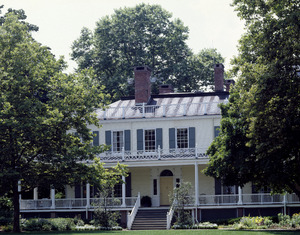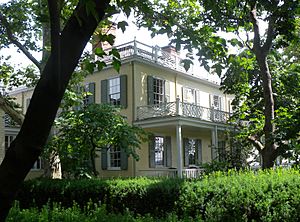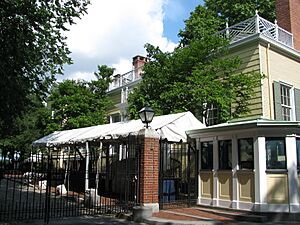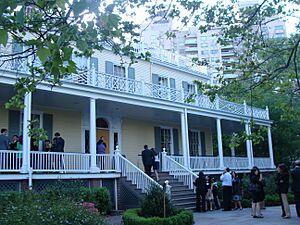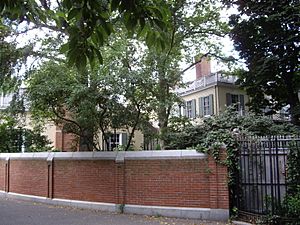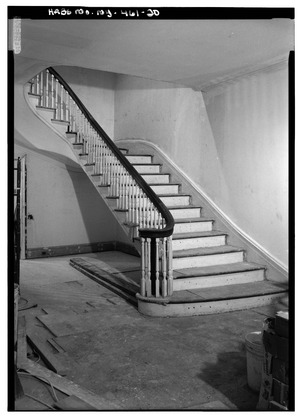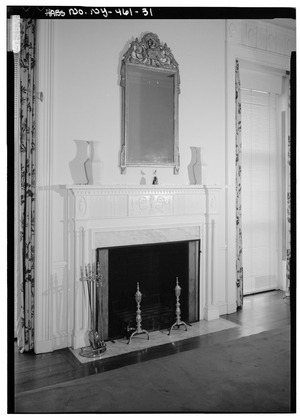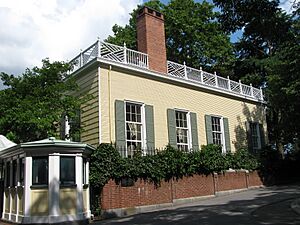Gracie Mansion facts for kids
|
Archibald Gracie Mansion
|
|
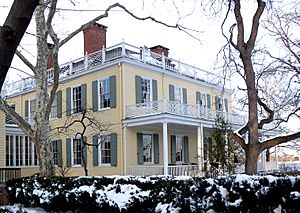
East front
|
|
| Location | East End Ave. at 88th St., Manhattan, New York |
|---|---|
| Built | 1799 |
| Architect | Archibald Gracie |
| Architectural style | Federal Style |
| NRHP reference No. | 75001205 |
Quick facts for kids Significant dates |
|
| Added to NRHP | May 12, 1975 |
Gracie Mansion is the official home of the mayor of New York City. It was built in 1799 and is located in Carl Schurz Park in the Yorkville neighborhood of Manhattan. This beautiful house, built in the Federal style, looks out over Hell Gate in the East River. It has the original two-story house and a newer part added in 1966. Gracie Mansion is a special New York City designated landmark and is listed on the National Register of Historic Places.
Before Gracie Mansion, another house called Belview Mansion stood on this spot. It was built in 1770 but was destroyed during the American Revolutionary War. In 1799, Archibald Gracie built the new house, using it as his country home. Over the years, different families lived there. From 1924 to 1936, Gracie Mansion was home to the Museum of the City of New York. It then became a historic house museum until 1942. Since then, it has been the official residence for New York City mayors. Most mayors have redecorated the house when they moved in. A new part, called the Susan Wagner Wing, was finished in 1966. The mansion has also had big renovations in 1983–1984 and 2002.
The outside of the house is made of wooden panels with shutters. Inside, the original house has living rooms, a dining room, a kitchen, and a library. The newer part has a ballroom and other reception rooms. The second floor is usually used for bedrooms, and the basement has offices. The Gracie Mansion Conservancy helps take care of the mansion, though the city still owns it. Gracie Mansion is used for government meetings, special events, and public tours. It has been featured in many books and movies.
Contents
Gracie Mansion's Location and History
Gracie Mansion is found in Carl Schurz Park in the Yorkville area of Manhattan, New York City. It faces northeast towards Hell Gate, a channel in the East River. This mansion is special because it is the only old country estate left in Yorkville. It sits on the highest point of Carl Schurz Park.
Early Land Use
Europeans first settled in New York City in the 1600s. The land where Gracie Mansion stands was owned by only six people from then until the late 1800s. The first European owner was Sybout Claessan, who received land from the Dutch West India Company in 1646. This area was known as Hoorn's Hook.
In 1770, Jacob Walton, a merchant, built a house called Belview Mansion on the site. It had a two-story middle section and one-story wings. The Waltons had to leave their home in 1776 during the American Revolutionary War. The site became a fort for the Continental Army. The house was badly damaged by cannonballs in September 1776. British troops then controlled the area until 1783.
The Waltons never returned to Belview. The mansion had a hidden tunnel that led to the East River. No one knows for sure why the tunnel was built. Some thought it was an escape route during the war.
The Mansion's First Owners
Archibald Gracie's Time
In 1798 and 1799, a rich merchant named Archibald Gracie bought Walton's land. Gracie built a new country home on the site in 1799. He also cleaned up the land and created beautiful gardens. At that time, Gracie Mansion was far from the busy parts of Lower Manhattan. You could only reach it by the East River. There was a dock and a stable nearby.
In 1801, Gracie hosted a meeting at the mansion to help start the New York Evening Post newspaper. When there was a yellow fever outbreak in 1803, the mansion's isolated spot helped Gracie avoid the sickness. The house was expanded in 1804 to face northeast. More additions were made in 1811, including a new entrance and more rooms. Cannons were placed near the house during the War of 1812 to protect it.
Gracie often had many guests, sometimes up to fifty at once. Famous visitors included Alexander Hamilton, John Jacob Astor, and future French king Louis Philippe I. U.S. president John Quincy Adams and writers James Fenimore Cooper and Washington Irving also visited. Irving once wrote that he found the mansion a "sweet and delightful retreat."
Gracie used the house as his country home until 1823. After the War of 1812, his money became low. Rufus King, a U.S. Founding Father, bought the mansion before 1823. King then put the mansion up for sale in April 1823.
Foulke and Wheaton Families
In 1823, Joseph Foulke bought the house and about 11 acres of land. He was a merchant who made his money from trading in Central America and the Caribbean. The Foulke family first used Gracie Mansion as a summer home, but later it became their main residence. They added a fireplace mantel but did not make many other changes. When Joseph Foulke passed away in 1852, the mansion went to his seven children.
In 1857, Foulke's family sold the house to a builder named Noah Wheaton. Wheaton added a two-story brick stable and a kitchen to the mansion. He also installed gas lighting. Wheaton faced money problems, and the house went into foreclosure in 1861. However, his family was allowed to stay. Wheaton's daughter, Alice Hermione Wheaton Quackenbush, and her husband lived in the mansion for five years in the 1870s. The house stayed with the Wheaton family until 1896.
City Takes Over Gracie Mansion
Becoming a Park Feature
In 1891, the New York City government took over the land around Gracie Mansion to create Carl Schurz Park. The city bought the house itself in 1896. The mansion was used for different things as part of the park. It was an ice cream stand, storage rooms, classrooms, and even public restrooms.
By 1911, the mansion was in bad shape. The porch was sinking, and the paint was peeling. Some people wanted to tear it down, but a group led by Mrs. Graeme Elliot worked to save it.
Museum of the City of New York
In the 1920s, groups wanted to turn Gracie Mansion into a museum. The Museum of the City of New York (MCNY) eventually took control of the mansion. The city government helped maintain the house. The MCNY opened its exhibits in the mansion in November 1924. After more work, it formally opened to the public in March 1927. The museum filled the mansion with items given or loaned by other places.
The mansion had many visitors, with 130,000 in one year. In 1928, the house's ceiling partly fell after explosives were set off in Hell Gate. The house closed for repairs. In 1931, the MCNY moved to a new building on Fifth Avenue. By August 1932, the museum had completely moved out of Gracie Mansion.
A Historic House Museum
In September 1934, a renovation of the house began. Park commissioner Robert Moses wanted to turn it into a historic house museum. Workers added new windows, a roof, and heating and lighting systems. Many organizations loaned furniture and art to the house. The Metropolitan Museum of Art provided paintings and furniture.
The renovation was finished in April 1936. The house displayed items like paintings, old beds, and furniture from the early 1800s. However, not many people visited because it was hard to get to by public transport.
Plans for the East River Drive (now FDR Drive) originally went through the mansion's lawn. But in 1938, the plan changed to a tunnel to save the mansion and its views. The tunnel was built very close to Gracie Mansion. During construction, many of the mansion's old items had to be stored away.
Gracie Mansion Becomes the Mayor's Home
Mayor La Guardia Moves In
In 1935, Robert Moses first suggested that New York City should have an official home for its mayor. Mayors usually lived in their own houses. In June 1941, Moses suggested Gracie Mansion to Mayor Fiorello H. La Guardia. La Guardia eventually agreed.
The plan to make Gracie Mansion the mayor's home was approved in December 1941. This made it one of the few official mayoral homes in the U.S. Workers started renovating the mansion on January 22, 1942. They added a master bedroom, kitchen, and offices for security. A new driveway and an iron fence were also added. The renovation was finished on May 21. The La Guardia family moved into the mansion on May 27, 1942. Mayor La Guardia liked to call it "Gracie Farm."
The La Guardia family lived on the second floor. They did not host many guests because of money and wartime rules. But they did welcome important visitors like the King of Greece and U.S. General Dwight D. Eisenhower. La Guardia used the mansion as a "summer city hall." The La Guardias moved out at the end of 1945.
Mayors in the Mid-20th Century
O'Dwyer and Impellitteri
When William O'Dwyer became mayor in 1945, he first said he would not move into the mansion. But he changed his mind, finding it offered more privacy. The mansion was repainted and refurnished. The O'Dwyers moved in at the end of January 1946. An elevator was installed for O'Dwyer's wife, Kitty, who was ill. She passed away less than a year later. Important guests included the president of Mexico and U.S. president Harry S. Truman. O'Dwyer left the mansion in August 1950.
Vincent R. Impellitteri became acting mayor in September 1950. He and his wife Betty moved in soon after. Betty Impellitteri decided not to redecorate the house. Impellitteri used the mansion for official visitors, but few people were invited during his time as mayor.
Wagner and the New Wing
Robert F. Wagner Jr. became mayor in 1953. He and his family moved into Gracie Mansion in January 1954. The house was repainted, and some rooms were refurnished. Wagner's wife, Susan, asked workers to seal the elevators so their young sons would not play with them. The Wagners added wallpaper and drapes.
Unlike earlier mayors, the Wagners hosted many guests. Susan Wagner held about four events a week. Almost all rooms were open to visitors. Guests included U.S. presidents Truman and John F. Kennedy. By 1957, Susan was hosting at least 125 events each year.
In 1963, a group formed to raise money to expand Gracie Mansion. Susan Wagner wanted a renovation and hired Edward Embry to design a northern addition. Susan passed away in March 1964. The new addition was named in her memory. The architect Mott B. Schmidt drew plans for a new west wing. This wing was meant for meetings and receptions.
Construction for the new wing began in May 1965. The Wagner family moved out of the mansion in September 1965. The new wing cost $800,000 and was finished in September 1966.
Lindsay and Beame
When John Lindsay became mayor in November 1965, his family temporarily lived in a hotel. His wife, Mary, wanted to help fix up the house. The Lindsay family, with their four children, moved to Gracie Mansion in March 1966. The inside was redecorated. The city spent money to install sprinklers because the house was a fire risk. Mary Lindsay preferred to host public events only in the new annex.
The new wing was officially opened on September 27, 1966. A garden was planted next to it for more privacy. The Lindsays' children had a playroom in the attic and a treehouse built by park workers. Mary Lindsay oversaw the redecoration of the mansion's interior. The family had pets like dogs and birds. Famous guests included Constantine II of Greece and actors Johnny Carson and Robert Redford.
After Abraham Beame became mayor in 1973, the house was renovated in January 1974. The Beames' friend, Joan Haber, helped redecorate. One bedroom became a sitting room, and another became a study. The Beames moved into Gracie Mansion at the end of February. They hosted guests like Japanese emperor Hirohito. After Ed Koch won the 1977 election, the Beames moved out just before Koch became mayor.
Koch's Time and Big Renovation
When Ed Koch moved into the mansion in late 1977, he brought some of his own things. He first preferred his apartment on weekends but later decided to live at Gracie Mansion full-time. Koch added some of his own decorations, like a wooden rabbit sculpture. He also added modern art to the mansion.
Koch was the first unmarried mayor to live there. His assistant, Dorothy Aschkenasy, helped manage the house. Koch hosted events three or four times a week for many different groups. He often invited dozens of people for breakfast and dinner. Guests included Israeli prime minister Menachem Begin and U.S. president Ronald Reagan. These events meant a chef had to live in the mansion. Koch started giving public tours of the house in September 1980, attracting many visitors.
The mansion needed more upgrades. In 1981, Koch announced a big renovation. He created the Gracie Mansion Conservancy in 1982 to help with the work. The project began in March 1983. It included new furniture, landscaping, a new porch, and updated systems like heating and electricity. Workers tried to restore the mansion to its original look.
The renovation was finished in November 1984. It cost $5.5 million, with $1 million from the city and the rest from private donations. Koch hosted over 23,000 guests the next year. The mansion became one of the first members of the Historic House Trust in 1989. Koch moved out after losing reelection later that year.
Dinkins and Giuliani
When David Dinkins won the 1989 election, his wife Joyce Dinkins decided not to change the decor much. The Dinkins family moved into the mansion in January 1990. Joyce Dinkins read to first-grade students there once a week. They also hosted "Kids Day at Gracie Mansion" every summer. Their most famous guest was future South African president Nelson Mandela.
After Rudy Giuliani became mayor in 1993, he, his wife Donna Hanover, and their children Andrew and Caroline moved in. The Giulianis hosted many events but wanted their children to have normal lives. Hanover became the chairwoman of the Gracie Mansion Conservancy. She raised a lot of money for the house's upkeep. The New York City Police Department upgraded the mansion's security system. The mansion was repainted, and Tiffany & Co. donated new china.
When Giuliani and Hanover separated in 2001, Hanover did not want Giuliani's girlfriend to move into the mansion. A judge agreed with Hanover, saying the children had a right to privacy. Giuliani moved out by July 2001.
Gracie Mansion in the 21st Century
Bloomberg's Time
When Michael Bloomberg became mayor in 2001, his partner Diana Taylor wanted to live in Gracie Mansion. But Bloomberg refused, saying it would be too expensive for taxpayers. He already had a home on the Upper East Side. The outside of the mansion was repainted in April 2002. A major restoration began that May. Bloomberg's decorator, Jamie Drake, designed the renovation. It included new systems and restoring historical parts. Bloomberg borrowed sculptures from the Museum of Modern Art for the lawn.
The project was finished in October 2002, costing $7 million. Most of the money came from private donations. During Bloomberg's time as mayor, the house was open to the public on Tuesdays. Bloomberg used the mansion for official visitors to stay. In 2003, the mansion hosted 178 events. It welcomed guests like South African archbishop Desmond Tutu and Norwegian Crown Prince Haakon.
By 2011, about 40,000 people visited the mansion each year. A kitchen renovation began in June 2012 and was finished the next year. Bloomberg never lived in the house during his time as mayor.
De Blasio's Time
Candidates in the 2013 mayoral election said they wanted to live in Gracie Mansion. The winner, Bill de Blasio, delayed moving in until his son finished high school. The de Blasio family started moving into the mansion in June 2014. They furnished the second floor with donated furniture. A tall fence was installed around the mansion for security. De Blasio's wife, Chirlane McCray, hosted several art exhibits at the mansion. By 2015, the roof was leaking and needed repairs.
Adams's Time
Eric Adams became mayor after winning the 2021 election. He and his family moved into Gracie Mansion. Adams said he might split his time between the mansion and his home in Brooklyn. The house continued to be rented out for events like weddings.
On September 26, 2024, federal agents visited Gracie Mansion. Adams's phone was taken during the visit. On January 1, 2025, a man climbed the mansion's fence and took some items before being arrested. Mayor Adams was not home at the time.
Gracie Mansion's Design
Archibald Gracie built the two-story wooden house in the Federal style. The design might have been by Pierre Charles L'Enfant, Ezra Weeks, or John McComb Jr.. The house was originally about 50 by 65 feet. Even though it's called a "mansion," some people think it's more like a charming country house.
Next to the original mansion is a separate two-story wing. This wing was designed by Mott B. Schmidt in a neo-Georgian style. It has its own entrance and is known as the Susan B. Wagner Wing.
Outside Features
The original mansion's outside walls were cream-colored wood panels with white trim and green shutters. It has been repainted many times. In 2002, the siding was painted a yellow-brown color, and the trim and shutters were repainted in their original colors. The windows are lined up evenly on the first and second floors.
There is a porch around the south, east, and part of the north sides of the house. The current porch, built in 1984, looks similar to the original one. It has columns and a railing. The main entrance has a doorway with six panels, a fanlight (a window shaped like a fan) above it, and sidelights (windows on the sides). This doorway was moved to the east side of the house by 1811. The roof has a decorative railing and four chimneys.
The south side of the house has four windows on each floor. The west side originally had four windows on each floor, but one was changed to connect to the new wing. The north side of the original house has a central part that sticks out with rectangular windows. The north side of the new wing has its own entrance with a portico (a porch with columns).
Inside the Mansion
Main House Rooms
The rooms in the main house still have the same layout as in 1811, but their decorations have changed. After the 1980s renovation, the mansion was decorated with chandeliers, mirrors, and other old items from the 1800s. The mansion has about 14 rooms and eight bathrooms. The rooms generally have fireplaces, high ceilings, and decorative borders on the walls.
First Floor
Originally, a hallway ran through the first floor with two rooms on each side. A living room and pantry were added in 1811. When it became the mayor's home in 1942, a living room, library, dining room, and kitchen were built on the first floor.
The entrance area has a black-and-white floor pattern that looks like marble. This floor was added in the 1980s and is based on the original design. The entrance also has a fireplace.
To the right of the entrance is the parlor, also called the living room. It has a large marble fireplace and tall windows facing the porch. To the left of the entrance is a dining room that can seat 22 people. After the 1980s renovation, it had French wallpaper from the 1830s showing country scenes. The dining table, made in 1815 for the Gracies, is made of marble and oak wood. The library is next to the dining room. Its windows have names etched into them by some of the mayors' children, like Caroline Giuliani and Georgina Bloomberg. Both the library and dining room are from the house's original 1799 build.
Other Floors
A curved staircase at the back of the house leads from the first floor to the second. The second floor originally had three bedrooms and two smaller storage rooms. In 1942, it was changed to have four bedrooms, each with its own bathroom, and a sitting room. One bedroom is for guests, and the others are for the mayor's family. When Ed Koch was mayor, a secure room was built in the bathroom next to his bedroom.
The basement originally had the kitchen and possibly staff rooms. The 1942 renovation added four rooms for staff, an office for the park caretaker, and an office for the mayor's security. There is also a gift shop in the basement.
The Wagner Wing
The Wagner wing almost doubled the mansion's size. It can seat up to 150 people. An outdoor terrace can hold another 150 guests. The wing has a Federal-style mirror and four fireplace mantels taken from other old houses in the city. Many antique furniture pieces were loaned or bought for the Wagner wing. Although the annex was finished in 1966, it was not connected to the main house for over 20 years. A hallway was built between the main house and the annex in the 1980s.
The wing has a hallway with a marble floor and a high ceiling. Inside the main level is a ballroom, which can be called the Susan Edwards Wagner Ballroom. It is about 48 by 25 feet and has a high, curved ceiling. The ballroom walls were originally decorated with French windows and gray-blue walls. A chandelier from 1783 hangs from the ceiling. A portrait of Susan Wagner is also displayed there. The ballroom's fireplace mantel came from the James Watson House, which belonged to Archibald Gracie's brother-in-law.
On either side of the ballroom are two smaller rooms: a dining room and a reception room. There is also a serving pantry. The basement of the wing has a conference room and offices for the mayor and their secretary.
How Gracie Mansion Works
Gracie Mansion has been the official home of the New York City mayor since 1942. Important guests can also stay there. The house is used for ceremonies and government meetings.
Gracie Mansion is still very valuable today. In 2008, one expert thought the house could be worth $250 million. Vanity Fair magazine estimated its worth between $125 million and $200 million in 2014. Because of its role, the mansion is sometimes called the "People's House" or New York City's "Little White House."
Taking Care of the Mansion
The New York City Department of Parks and Recreation has owned the house for a long time. The Gracie Mansion Conservancy, a group formed in 1981, helps take care of the mansion. This group was created to restore and preserve the house. The Conservancy also organizes educational programs and events. In 2012, it had a budget of $1.7 million each year, mostly paid by the city. The house is part of the Historic House Trust.
Visiting Gracie Mansion
Gracie Mansion was closed for public tours between 1942 and 1980. But since then, it has often been open to the public, even when the mayor lives there. As of 2024, the Gracie Mansion Conservancy offers tours of the first floor one day a week. Visitors are not allowed to take photos except in the Wagner Ballroom. The public is also invited for special events like annual trick-or-treating.
Besides official business, Gracie Mansion has hosted other events. Its first fashion show was in 1956. It has also held art exhibitions, including one in 2015 about minority groups and one in 2019 about women's paintings. The mansion has also been used for clubs like the Gracie Book Club.
What People Think of Gracie Mansion
How People See It
In 1913, a writer said the mansion showed "evidences of its old-time grandeur." Another writer in 1922 said, "no resident of such a mansion could wish to travel or to forsake its cheerful rooms." The Atlanta Constitution called it "a worthy example of the solidity and beauty of early New York architecture" in 1927. A writer for The Christian Science Monitor in 1941 said the site was "a most fitting frame for the office of the city's Chief Executive." The New York Herald Tribune wrote that no other mayor's home in the city's history was "more gracious or larger."
When the Wagner annex was planned in 1965, architecture critic Ada Louise Huxtable called it "notable for its scholarly and appropriate good taste." After it was finished, she said the annex "is worth every penny that the city did not spend." The Christian Science Monitor wrote in 1966 that the annex was "of architectural and interior distinction."
In 1973, the New York Daily News called the mansion "a dignified dowager of early American architecture." After the 1980s renovation, a reporter wrote that "it is the interior decoration that has literally transformed the house." A reviewer in 2017 said that "Gracie Mansion abounds in architectural and decorative interest."
Keeping it Safe
Gracie Mansion was one of 6,500 buildings photographed for the Historic American Buildings Survey between 1933 and 1942. The New York City Landmarks Preservation Commission named Gracie Mansion a city landmark in 1966. It was added to the National Register of Historic Places in 1975.
In Movies and Books
The mansion was shown in a 1952 exhibit of historic homes. It was also the subject of another exhibition in 1981. In 1966, after the Wagner wing was finished, the mansion was shown on a TV broadcast. A book about the mansion's history was written during its 1980s renovation.
Gracie Mansion has also been featured in movies and books. The TV show The Yule Log was filmed there in 1966. Scenes in the 1974 film The Taking of Pelham One Two Three showed the house. The movies Ghostbusters II (1989) and City Hall (1996) were set at Gracie Mansion. The 1997 novel The Puttermesser Papers by Cynthia Ozick also used it as a setting. The 2010 novel Hell Gate by Linda Fairstein used the mansion and its surroundings a lot.
Ghost Stories
Chirlane McCray, Mayor de Blasio's wife, has said the mansion is haunted. She claimed to hear doors opening and closing by themselves and creaks from the wooden floor. She also said she heard whispers from Archibald Gracie's daughter.
Mayor Eric Adams has also said the mansion is haunted. He repeated McCray's claims and said he saw objects moving around. When asked if the mansion was cool enough for him, he replied, "No, it’s not, trust me, .... I don’t care what anyone says, there are ghosts in there, man." Some people think these ghost stories might be why Adams has not stayed in the mansion for long periods.
See also
 In Spanish: Gracie Mansion para niños
In Spanish: Gracie Mansion para niños



